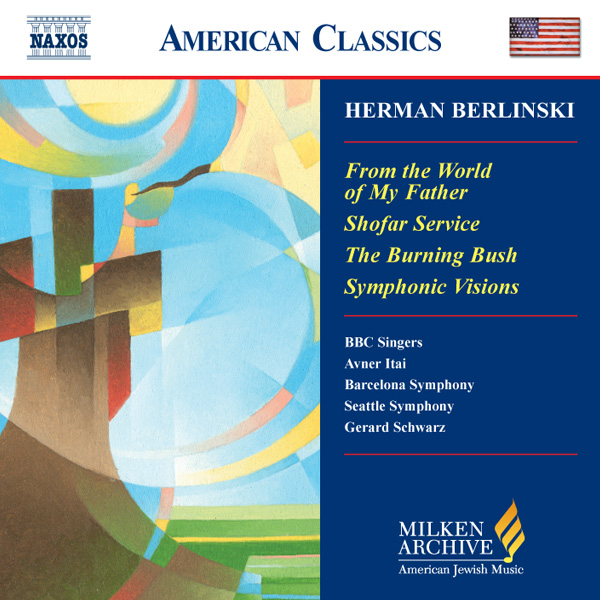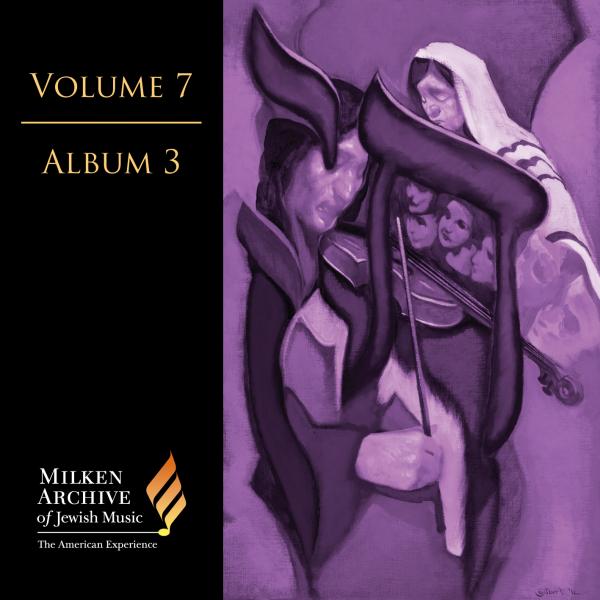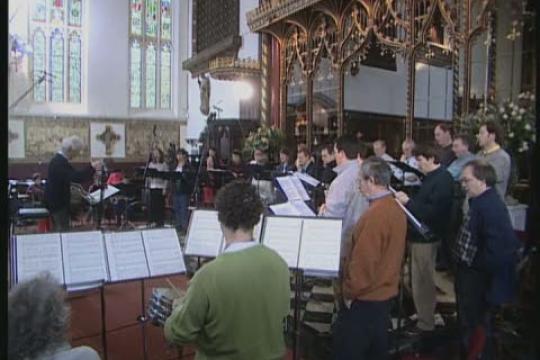Tracks
Liner Notes
Although its most obvious reference point for American Jewry concerns Rosh Hashana (the Jewish New Year), the biblical trumpet/clarion-like wind instrument known as the shofar,usually made from a ram’s horn, should be defined more generically as a ritual horn of ancient Israel. It was employed on many occasions in Jewish antiquity.
Those included proclamations of the Jubilee Year, military purposes, numerous religious ceremonies not restricted to Rosh Hashana or Yom Kippur, warnings of approaching danger, summoning the people for fast days, announcements of the advent of peace, proclamations of the reign of a new king, and the signaling of many other public events. The shofar may be the oldest surviving wind instrument used continuously in its original form among the Jewish people. Because of that, it is the only biblically mentioned musical instrument (wind or other) whose identity is known with certainty. In addition to objective historical accounts and other evidence, there are earlier references: Scripture, for example, describes the revelation at Sinai as introduced by the shofar (Exodus 19:16), causing the people to tremble; and there is ample additional biblical testimony to the variety of its uses.
Postexilic and especially modern Jewry’s chief acquaintance with the shofar, however, derives from its central ceremonial position in the Rosh Hashana morning service: the rabbinic requirement, which carries the force of Scriptural commandment, that all Jews “listen to the sound of the shofar” on Rosh Hashana, and its prescribed number and types of intonations or “blasts” at specific points in the service. As the single most prominent feature in Rosh Hashana observance, even the instrument’s image has become a visual symbol for the Jewish New Year and its seasonal approach.
A shofar can be made from the horn of any legally permitted, i.e., “kosher,” animal, except for an ox or a cow—because of the association with the golden calf incident in the Bible. The ram’s horn, however, is preferred for Rosh Hashana because of the connection with the biblical story of the binding of Isaac (akedat yitzḥak) and Abraham’s substitution of a ram for the sacrifice—the assigned Torah reading for the first day of Rosh Hashana and the theme of an important part of its liturgy. The shofar blasts are partly a recollection of that patriarchal demonstration of faith and obedience.
The shofar sounds on Rosh Hashana also have been described as recalling those at Mount Sinai, with the hoped-for dual effect of reminding the Jewish people of the obligation undertaken then and of jolting them now, by the shofar’s strident sounds, to resolves of self-review and moral rehabilitation. Moses Maimonides (1135–1204), the great medieval Jewish philosopher and commentator, interpreted the shofar sounds on Rosh Hashana as proclaiming, “You who are asleep, awake! Search your deeds and repent. Examine your souls, you who indulge all during the year in trifles. Amend your ways and let each one abandon his evil course and purpose.”
The shofar has yet another, but related, symbolism in the service. God’s sovereignty forms one of the principal themes of the Rosh Hashana liturgy, and the shofar blasts pertain to that as well: to the annual renewal of the people’s acknowledgment and confirmation of that sovereignty—appropriately, on the anniversary of creation. Additional justifications and rationales for the shofar’s connection to Rosh Hashana were offered as early as the 10th century by Rav Saadia Gaon: its reminder of prophetic warnings and exhortations; its use as a battle alarm in ancient Judea; its announcement of the “day of judgment,” another name for the Jewish New Year and one of its central themes; its inspiration of awe and reverence as well as hope for ultimate redemption and national restoration; and its identification with the concept of t’ḥiyat hametim, revival of the dead.
The Torah itself does not specify the shofar unmistakably as the instrument for the prescribed trumpetlike blasts in the Rosh Hashana ritual (nor does the term rosh hashana for “New Year” or its holy convocation actually appear in the Torah; the term appears only once in the Bible, in Ezekiel 40:1, in another connection). However, rabbinic tradition determined this instrument to be the shofar, as implied in Numbers 29:1 (“day of t’ru’a”) and Leviticus 23:24 (“memorial of t’ru’a”), the term t’ru’a referring to one of the specific motivic trumpetlike articulations.
On Rosh Hashana the sounding or blowing of the shofar begins with short, plaintive call patterns and ends with a triumphant optimistic motif. The basic calls consist of three patterns, mostly outlining the interval of a fifth: (1) the ordinary and short t’ki’a, which ends abruptly; (2) the broken or detached sh’varim, with its three repeated quasi-staccato motives; and (3) the t’ru’a, a succession of rapidly repeated blasts on the same approximated pitch, equal to three sh’varim and preceded by a pickup or appoggiatura a fifth below. In the Rosh Hashana ritual these calls are arranged in various combinations: a) t’ki’a, sh’varim, t’ru’a, t’ki’a; b) t’ki’a, sh’varim, t’ki’a; c) t’ki’a, t’ru’a, t’ki’a—and in the final rendition of the series, a t’ki’a g’dola, the prolonged final t’ki’a generally sustained to the physical capacity of the blower.
Although some established practices provide for additional shofar soundings, the basic shofar ritual occurs at two principal places in the standard traditional Rosh Hashana liturgy, in the following order:
1. Within shaḥarit (the morning service), just before the conclusion of the Torah service (biblical readings) and prior to the return of the scrolls to the ark. This initial shofar ceremony, which may be considered a subsection of the larger Rosh Hashana morning service, is known as t’ki’ot m’yushav, and many traditional prayerbooks also refer to it in English simply as the “shofar service.”
2. In the musaf service (the additional liturgy that proceeds directly from shaḥarit on Sabbaths, holydays, and each new moon observance) at three consecutive points, where the shofar sounding each time follows a series of biblical citations that addresses one of the several central conceptual-theological themes of Rosh Hashana. Each of these three series of biblical verses is surrounded by a prologue and a postludal prayer, concluding with a related, thematically specific b'rakha (plural, b'rakhot)—the generic term for an anaphoric prayer formula commencing with the phrase barukh ata adonai (You are worshiped, Lord) and proclaiming to God that He is to be worshiped for a particular attribute or for having provided a particular commandment. (Notwithstanding its common but misleading translation as “blessing,” or, only a bit less inaccurate, as “benediction,” the term b'rakha has no acceptable English equivalent.) A shofar sounding proceeds after the pronouncement of each of those three b'rakhot. The liturgical subdivisions formed by these three sets of biblical verses and their corresponding b'rakhot and shofar soundings are known respectively as malkhuyyot ([verses of] divine sovereignty), zikhronot ([verses of] historical remembrance), and shofarot ([verses pertaining to] trumpetlike or shofar sounds in connection with their heralding divine revelation and fulfillment of the divine promise for messianic ultimate redemption and liberation). Each of these three related shofar soundings within the musaf service therefore relates to one of those themes.
There are variations among particular traditions, but the text of the initial t’ki’ot m’yushav ceremony has become more or less crystallized over the centuries. It consists of two b'rakhot immediately preceding the series of shofar calls and blasts. The first b'rakha here reinforces the rabbinic requirement to “hear the voice of the shofar.” The second one is a more general expression of worship of God for having permitted the people to live to witness and partake of a joyous occasion (she’he’ḥeyanu, v’ki’y’manu, v’higi’anu...). (Neither b'rakha is repeated in the second, musaf shofar ritual.) This initial shofar ceremony is also surrounded by recitations of Psalm verses: introductory verses from Psalm 47; Psalm 118:5 (min hametza... —“Out of the depths I called upon the Lord...”); six additional selected verses; and, at the conclusion of the ceremony, following the t’ki’a g’dola shofar blast, a selection of verses that varies among rites but always includes Psalm 89:16 (“Happy is the people that knows the sound of the shofar [trumpet blast]...”
For the standard classical Reform service of Berlinski’s day, the Union Prayerbook—which basically eliminated the musaf (and most of its distinct liturgy) as a separate additional service or section—incorporated an abbreviated and modified combination of those two principal traditional shofar rituals (shaḥarit and musaf occurrences), combining some of the two liturgical functions as well. The two b'rakhot of the t’ki’ot m’yushav are retained (though not included in Berlinski’s setting); but the Psalm verses, partly out of theological considerations, are unrelated to those of the traditional t’ki’ot m’yushav and contain only short references to some of the biblical citations preceding the shofar soundings in the traditional musaf—and in the Union Prayerbook they appear only in English. The shofar calls themselves are also reduced—from the original thirty, in the t’ki’ot m’yushav alone, to ten, providing the intended flavor without being bound by legal prescriptions. This is the version upon which Berlinski built his composition.
Like most of his liturgical music, Berlinski’s Shofar Service was created for the Reform format.
Therefore, in his score he also followed the somewhat misleading labels in the Union Prayerbook that designate its three abbreviated sets of shofar calls as malkhuyyot, zikhronot, and shofarot, after those liturgical sections in the traditional Rosh Hashana musaf liturgy. Yet in format and substance those musaf elements are really not self-contained parts of the Union Prayerbook’s distillation. True, the added English readings for the rabbi or other officiant (and some for responsorial English reading with the congregation), incorporated into the Union Prayerbook text for this single abridged shofar ceremony, do make some deliberately vague references to concepts or themes derived from those three parts of the traditional Rosh Hashana musaf. But these words are extracted and represented in more universal terms, eliminating their core particularistic allusions to Jewish nationhood, to any special relationship between God and the Jewish people as the beneficiary of the covenants, or, especially, to the role of the shofar in heralding redemption in messianic nationalistic terms of a return to Zion or restoration of national sovereignty. Therefore, the superimposed malkhuyyot, zikhronot, and shofarot labels notwithstanding, neither the shofar element of the service in the Union Prayerbook nor Berlinski’s composition is substantively related to those musaf liturgies.
Traditionally, each shofar call is announced or “prompted” by a spoken voice only roughly approximating two or three pitches—almost akin to a sprechstimme, but not formally “sung”; and this is more often than not done by a lay reader. (The original purpose of these “prompts” for each shofar call was simply to preclude mistakes.) Berlinski’s entire piece is, however, a highly stylized artistic setting of the shofar service. He therefore followed the more common Reform practice (especially of that time) on calling for a trained voice (usually the cantor in most Reform synagogues then) to sing those announcements (t’ki’a, etc.) as solo passages in a sustained, westernized metrical framework over an organ pedal. In most Reform congregations of that period, traditional-sounding layman’s calls would have come across as unprofessional and undignified. Nor would that have fitted into so sophisticated a musical conception as Berlinski’s composition.
On the other hand, Berlinski deliberately designed his piece in order to reintroduce the authentic shofar to many Reform congregations for whom it may have been a new experience; and he specifically employed the traditional shofar calls, even if he recast them within his more classical stylization. That in itself could have been seen as a bit adventurous in 1964, although the trend in recent years among Reform congregations has been to return to some of the traditional elements of the shofar ceremony. At one time, however, many (but by no means all) Reform congregations had long since dispensed with the actual shofar. They perceived it as primitive sounding, raucous, informal, antiquated, and therefore inherently inappropriate to their religious aesthetics; notwithstanding its historical role in the synagogue, it would have been viewed as out of character in a modern, dignified American worship service. In this they were following in the footsteps of some of the early extreme Reform German services dating to the early 19th century. Long before Berlinski’s composition, many American Reform congregations simply substituted a modern trumpet. Others had a trumpet mouthpiece built into a real or simulated ram’s horn, amounting essentially to a bugle or valveless trumpet in shofar camouflage, while still others relied altogether on the organ’s trumpet stop. Berlinski’s work stands as a groundbreaking innovation in its skillful juxtaposition of old and contemporary elements—the shofar and modern instruments, Hebrew and English, age-old musical motives and original composition. It gives one the feeling of soaring to imaginary heights, with the two trumpets vying for primacy and then resolving peacefully with the choir. Moreover, apart from its obvious artistic value, it did find substantial acceptance in Reform Rosh Hashana services during the 1960s and 1970s, especially among those congregations with sophisticated music programs and the necessary resources. And despite a return to more basic tradition in some Reform congregations since then, the piece is still heard as part of the Rosh Hashana repertoire in many synagogues at the beginning of the 21st century.
The articulation patterns for the sounding of the shofar are derived historically (viz., in the Talmud) from those specified in the Torah for the ḥatzotzrot. Ḥatzotzrot refers there to a different, specifically metallic trumpetlike instrument, which was sounded in antiquity on various occasions—including holy days, when they were sounded in pairs. Some organologists consider the ḥatzotzra (sing for ḥatzotzrot) a forerunner of the modern brass trumpet.
Berlinski’s juxtaposition of two modern trumpets against an authentic shofar was both ingenious and creatively reflective of antiquity. The Mishna refers to sounds of the shofar being augmented by “two ḥatzotzrot” in the Temple on Rosh Hashana. The derivation of that practice has been ascribed to the coronation ritual of Israelite kings. In the Rosh Hashana Temple ritual, it thus related to one of that holy day’s central themes: God’s kingship. In the context of sociopolitical history, it has also been proposed that the combination of instruments represented a compromise in what was a centuries-old struggle between the priestly and popular classes, on the grounds that the earliest shofar uses were a function mostly of the populace and its folkways, whereas the ḥatzotzrot were used almost exclusively by the priests as an aristocratic displacement of the popular instrument.
The Mishnaic reference to that mixed instrumental ensemble, however, describes not the ordinary shofar used for nonreligious purposes, but one “overlaid with gold” for Rosh Hashana (and silver for public fast days). After the destruction of the Second Temple, in 70 C.E., the ḥatzotzrot were no longer part of the Rosh Hashana ritual, which thereafter included only the shofar.
Berlinski thus drew upon two related historical aspects of the ancient Temple Rosh Hashana ritual: the precedent of the shofar in conjunction with metallic trumpetlike instruments, and, poetically, the specially adorned shofar. As he characterized his approach, “I wrote a piece for a shofar overlaid with—that is, surrounded by—brass!”
Lyrics
English text from the Union Prayerbook
I. MALKHUYYOT
t’ki’a. sh’varim. t’ru’a. t’ki’a.
The Lord reigneth, He is clothed with majesty. The Lord is girded with strength. Thy throne is established of old. Thou art from everlasting to everlasting.
II. ZIKHRONOT
t’ki’a. sh’varim. t’ki’a.
For the mountains shall depart and the hills be removed, but My kindness shall not depart from thee, neither shall My covenant of peace be removed, saith the Lord that hath compassion upon thee.
III. SHOFAROT
t’kiya. t’ru’a. t’ki’a g’dola.
All ye dwellers on earth, when the shofar is sounded, hark ye, and when the trumpet is blown, come and worship the Lord. Come ye! And worship the Lord at the holy mountain. The Lord of Hosts shall be a shield unto thee.
Credits
Composer: Herman BerlinskiPerformers: BBC Singers; Christopher Bowers-Broadbent, Organ; Ted Christopher, Baritone; James Ghigi, Trumpet; Avner Itai, Conductor; Stephen Keavy, Trumpet; Tim Roseman, Shofar
Publisher: David Berlinski


